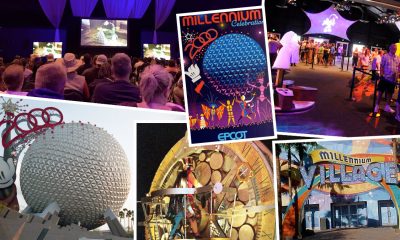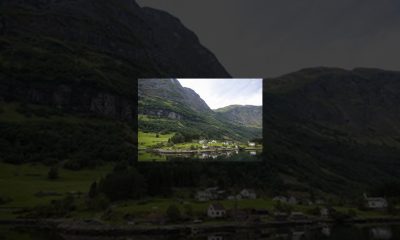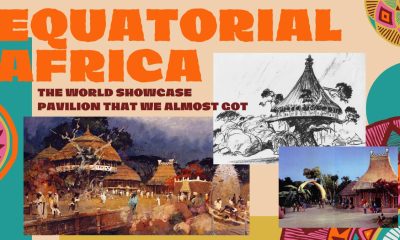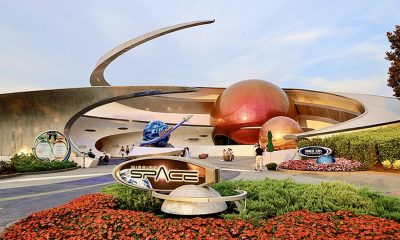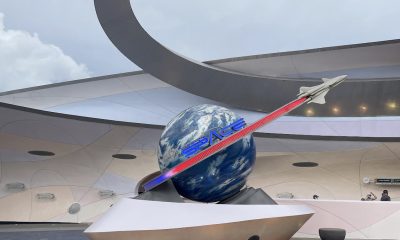History
Walter Cronkite & How Celebrities Made It In EPCOT Center
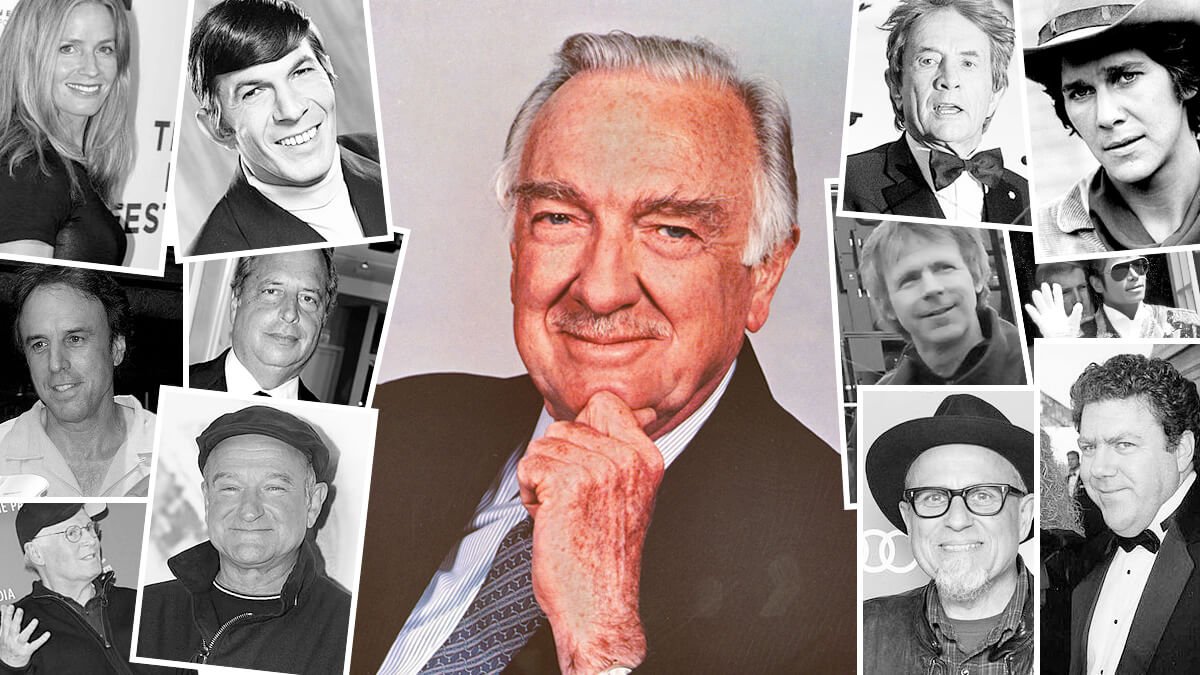
Are you familiar with the musical “Chicago”?
Fred Ebb & John Kander wrote a great song for that show called “Razzle Dazzle” which talks about how you can literally get away with murder – provided, of course, that you put on a good show first.
“Razzle Dazzle” has so many great lyrics. It’s hard to settle on a favorite. Take — for example — this chunk:
Give ’em an act with lots of flash in it
And the reaction will be passionate
Give ’em the old hocus pocus
Bead and feather ’em
How can they see with sequins in their eyes?
To start, I want to share one key couplet from this show tune:
Throw ’em a fake and a finagle
They’ll never know you’re just a bagel
Michael Eisner – Fix EPCOT Center
So it’s late September of 1984. And Michael Eisner has just been installed as the new head of The Walt Disney Company. One of Michael’s very first duties is to fix EPCOT Center – which is about to celebrate the second anniversary of its grand opening.
Mind you, no one in management at the Walt Disney World Resort much feels like celebrating this anniversary. Especially given that attendance levels at EPCOT have fallen through the floor.
You see, word has gotten out among the theme park-going public that EPCOT Center — while beautiful designed & well-meaning — is a bagel. Not an Everything Bagel, or even an Onion Bagel or a Sesame Seed Bagel. But just a plain ordinary bagel.
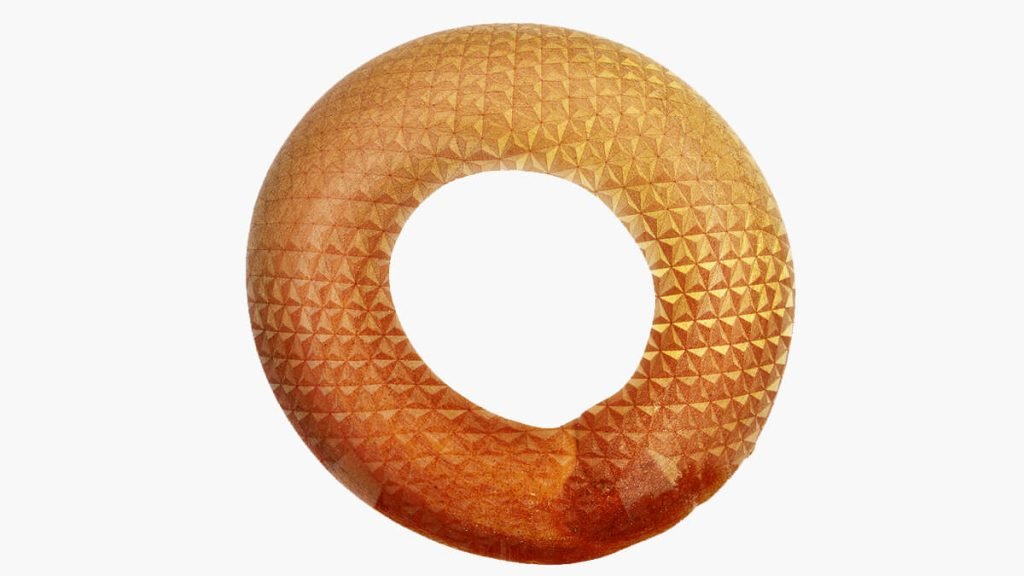
So Michael needs to find a way to make this bagel not seem quite so plain. Now you have to remember that Eisner came over to Disney from Paramount. Which was the hottest studio in Hollywood in the early 1980s.
So when Michael had a genuinely terrible movie during his days at Paramount …
How Eisner Fixed “Staying Alive”
Example: “Staying Alive,” the 1983 sequel to Paramount’s mega-hit from 1977, “Saturday Night Fever.” “Staying Alive” was so terrible — it got such miserable reviews nearly 40 years ago — it has the distinction of being the oldest film on Rotten Tomatoes to get a 0% freshness rating. As in: There are NO good reviews out there anywhere for this Sylvester Stallone movie.
Yes, I know. I said a “Sylvester Stallone movie.” Though John Travolta may have been the star, reprising his role as Tony Manero from “Saturday Night Fever,” Stallone not only directed this movie, he also co-wrote & co-produced this Paramount Pictures production. Because — of course — when you’re thinking of mounting a modern movie musical, the very first name that immediately comes to mind is Sylvester Stallone.
Anyway, Michael sees the rough cut of “Staying Alive” prior to its release to theaters in July of 1983 and realizes that it’s a dud. But then Eisner decides that — in this particular situation — the best defense is a good offense. So Michael first has “Staying Alive” booked on 1660 screens nationwide. Eisner then sends Travolta & Stallone on this giant publicity tour, where this pair appears on every morning news program and every late night talk show.
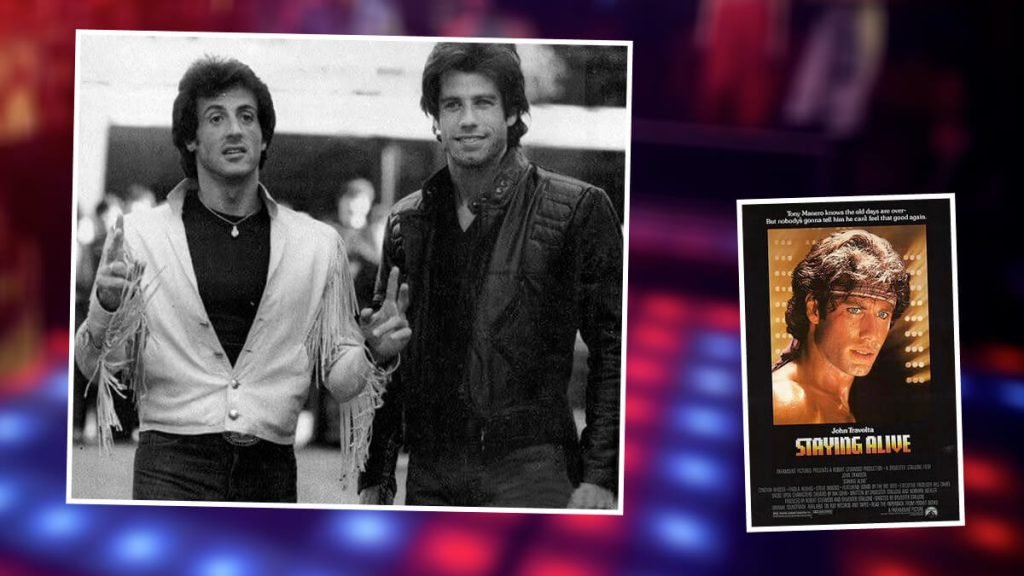
The end result is … Despite withering reviews, “Staying Alive” has the biggest opening weekend for a modern movie musical. It sold $12.1 million worth of tickets in North America. A record that this Sylvester Stallone movie held for 9 years ‘til Disney’s “Aladdin” opened in theaters in November of 1992 and then sold $19.2 million worth of tickets over its opening weekend in North America.
So Michael obviously knew the value of celebrity. That the right name — applied in the right way, of course — could quickly turn around the public’s reception of a project.
Eisner Adds Celebrities in EPCOT Center
So when it came to EPCOT Center — which the public thought of as … Well .. Earnest. Educational. But not all that entertaining. Well, the quickest fix here was to throw a few celebrities at this theme park.
But where to start? How about with EPCOT’s thesis attraction, Spaceship Earth. This 180-foot-tall geodesic sphere was typically the very first thing that Guests encountered as they entered this theme park. It was also usually the very first Future World attraction that Guests queued up for.
So who did Disney originally get to narrate EPCOT’s thesis attraction? The really big show at this theme park? Vic Perrin.
There will now be a short pause for those of you who need to say “Who?”
FYI: Jack Benny did a variation of this very same gag when he made his debut on radio back in May of 1932. 90 years ago this month. What he said at that time was “This is Jack Benny talking. There will now be a short pause while you say ‘Who cares?’”
Anyway … If you’re a fan of the original “Star Trek” series, maybe you’ll recall Perrin’s brief appearances on that legendary TV show. He appeared as the two Tharns in “Mirror, Mirror.” Also as the voice of Nomad in “The Changeling.”
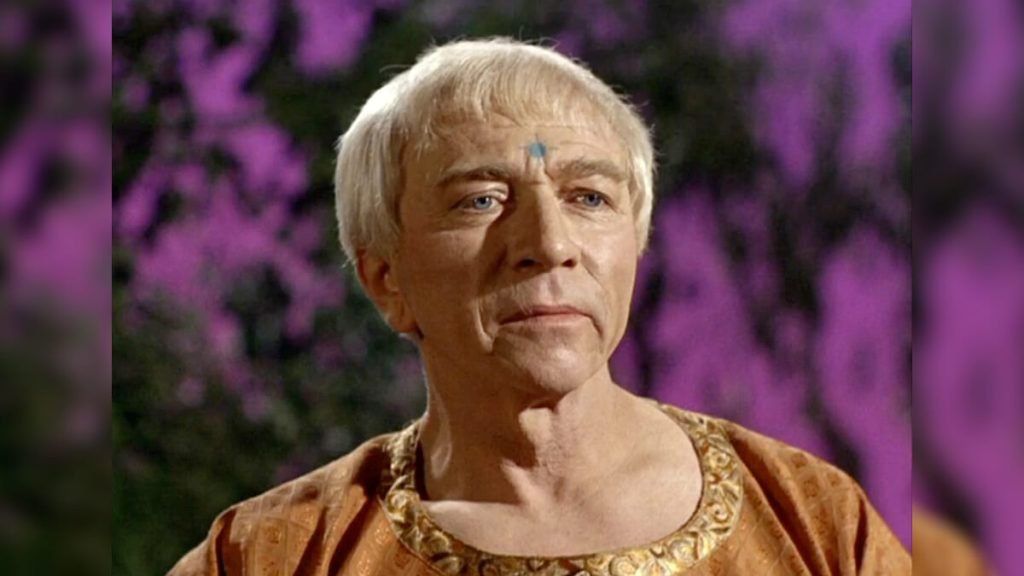
Speaking of Perrin’s voice … If you know your 1960s sci-fi television series, maybe you remember “The Outer Limits.” Which was ABC’s response to the success of “The Twilight Zone.” Which aired over on CBS.
Vic was the voice you heard at the very start of “The Outer Limits.” “There is nothing wrong with your television set. We will control the horizontal. We will control the vertical.”
That’s the theory, anyway, as to how Vic Perrin got the gig of narrating “Spaceship Earth” as well as EPCOT’s “Universe of Energy” pavilion. That there was a senior member of the Imagineering team who really liked “Star Trek” or “The Outer Limits” and then hired Perrin to be the voice of two Future World attractions which then sat side-by-side.
I’ve often wondered about visitors to the original version of EPCOT Center who — after they’d experienced Spaceship Earth — then went over to “Universe of Energy” only to then think “The Outer Limits Guy again? Really?”
So no disrespect to Vic. But Mr. Perrin — at least as far as Michael Eisner was concerned — wasn’t really a name. And if Eisner was looking to make EPCOT Center suddenly seem … Well, sexy & exciting, the thesis attraction for this theme park was going to need a name narrator. Someone that the Guests would immediately recognize from the very first second the narration of that attraction got underway.
But who would that be?
Bringing Back “The Disney Sunday Night Movie”
Let’s jump ahead now to the Summer of 1985. Where Walt Disney Productions has just cut a deal with ABC to revive the Studio’s Sunday Night anthology. Which started out life as “Walt Disney’s Wonderful World of Color,” changed — upon Walt’s death in December of 1966 — to “The Wonderful World of Disney.” That long-running show — which eventually moved from NBC to CBS — went off the air in September of 1983. Largely because the Company didn’t want people to be getting Disney content for free anymore after the Disney Channel had officially launched in April of that same year.
But now Michael Eisner was in charge of the Mouse House. And he wanted Disney back on network TV — if only for the sort of exposure a show like that would get. Which is why the Studios was now readying a new two-hour-long movie of the week series (which would be called — appropriately enough — “The Disney Sunday Night Movie”) for launch in early February of 1986.
But then the question was … Who would be the host of “The Disney Sunday Night Movie” show? Walt had done such a wonderful job of hosting “The Wonderful World of Color” in the 1960s that he was deemed a tough act to follow. But since the thinking was — at that time, anyway — that this show needed an MC of some time … Well, a casting call went out and some legendary entertainers were considered for the role. Among the original candidates were:
- Dick Van Dyke (kind of a no-brainer, given Dick’s ties to the Studio’s then-biggest hit, “Mary Poppins”)
- Danny Kaye (Also kind of a no-brainer. But given how miserably Kaye had behaved during the making of the EPCOT Center grand opening TV special — at one point, Danny deliberately dropped his pants on camera as he was directing the West Point choir, going out of his way to ruin a shot that had taken hours to set up — Kaye was quickly dropped from the candidate list)
- Peter Graves (The star of TV’s “Mission: Impossible.” Also Eisner had worked with Graves on “Airplane!,” which had been a huge hit for Paramount Pictures in the Summer of 1980. Michael liked Peter personally)
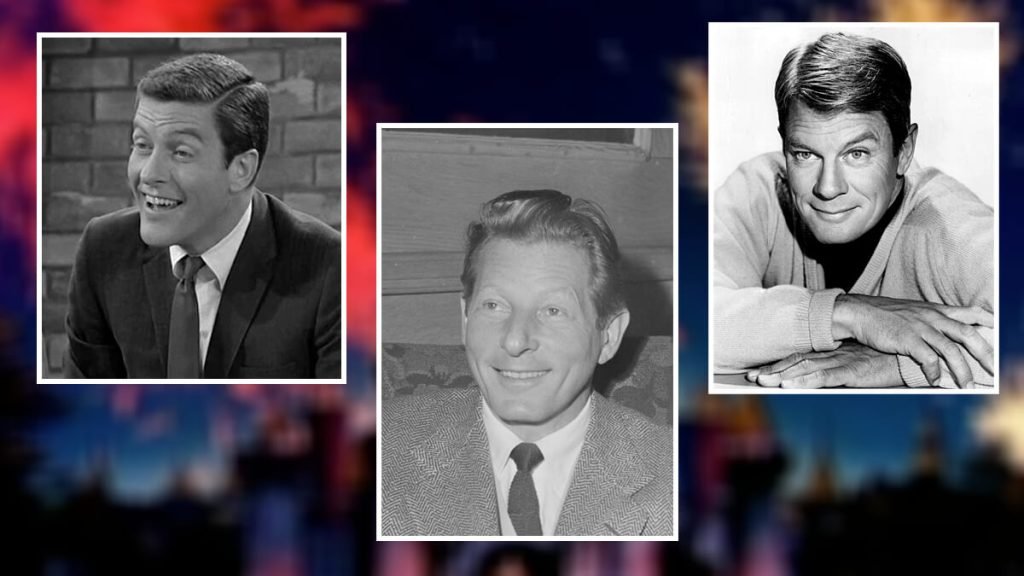
But because Eisner wanted “The Disney Sunday Night Movie” to be perceived as important … Well, he wanted a really big name to serve as the host of the revival of this long-running show. Someone like — well — the most trusted man in America.
Walter Cronkite – The Most Trusted Man in America
And in the mid-1980s, when you said a phrase like that (i.e., The most trusted man in America), only one name came up. And that was legendary newsman Walter Cronkite. Who — in March of 1981 — had stepped down as the anchor of “The CBS Evening News” after a 19 year run on that news program. Cronkite handed off that job to Dan Rather, who then went on anchor “The CBS Evening News” for a longer stint than Walter did. Rather stayed on in that job through March of 2005. Some 24 years, only to then be forced to step away from the CBS news desk because Dan got caught up in a scandal related to then-President George W. Bush’s supposed service with the Texas Air National Guard.
Okay. So it’s now four years after Walter has effectively retired from CBS (Cronkite still kept his hand in, though. Building on his years as a field correspondent covering the North Africa & European campaigns, Walter narrated a series of documentaries about the War entitled “World War II with Walter Cronkite.” That multi-part series began airing in 1983). And the question then became “Well, how did we get ahold of this nearly 70-year-old man? Make him aware that we want him to come in & audition for the role of host / MC on the ‘Disney Sunday Night Movie’ ?”
This is when Walt’s nephew — Roy E. Disney — stepped up and said “Leave that to me.” You see, Roy E. was an enthusiastic sailor. And he knew that Cronkite shared this passion. So Roy E. quickly arranged a trip out to Martha’s Vineyard (which is where Walter had retired to) and then — through friends there — set up a meet with Cronkite.
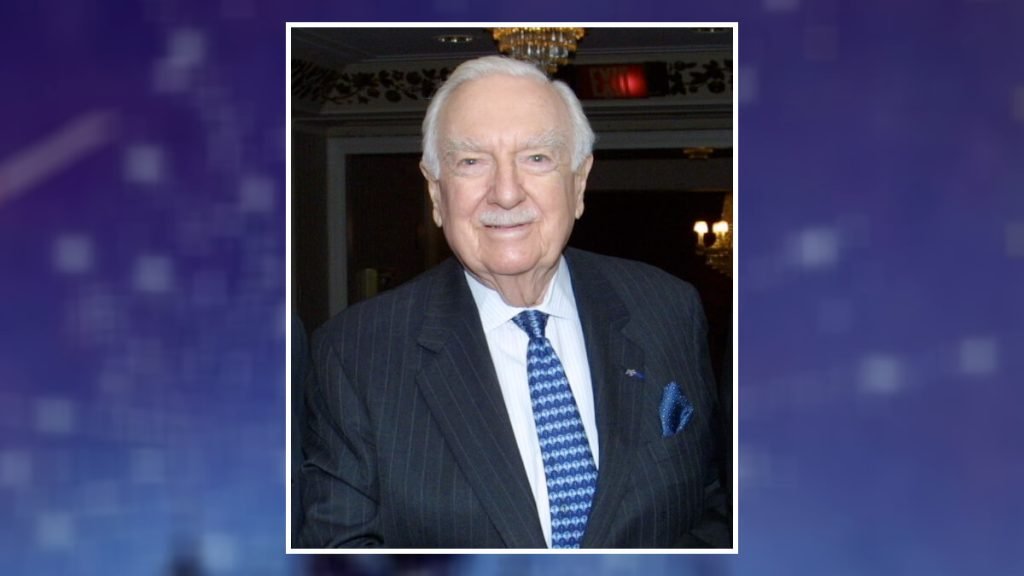
And I have to say that — from what I’ve been told — Cronkite was genuinely flattered by this offer. He had huge respect for the Disney organization. But as Walter reportedly told Roy E. “I’m retired now. I don’t want the hassle that comes with working on a weekly show. Besides, Walt Disney is a tough act to follow.”
So Walter politely but firmly turned that MC / hosting gig down. Which is how — almost by default — Michael Eisner then became the MC / host of “The Disney Sunday Night Movie.” By Michael’s own admission, he was initially terrible at this job. Eisner’s own wife Jane reportedly told him that he looked terrible on camera. Awkward & stiff. But Michael kept at it. He even hired Michael Kay, who was this political consultant who specialized in creating campaign ads that made politicians who were just terrible in front of the camera look natural & folksy. Kay began working with Eisner on improving his on-camera performance. And over time, Michael got better at his hosting gig.
Getting Walter Cronkite into EPCOT Center
Back to Walter Cronkite now … Now that the Company had opened a line of communications with the most trusted man in America, the question now was: How do we take advantage of this? It was clear — from what Walter had told Roy E. — that he wasn’t willing to take on a full-time gig at this time. But what about a project that would only take up — say — a day or so of Mr. Cronkite’s schedule?
And remember: This is when Michael Eisner was looking to bedazzle EPCOT Center. Get some celebrities inserted into this Park to make it seem more excited & entertaining. You have to remember that this is late 1985 / early 1986. And the Company had already announced its deals with Michael Jackson & George Lucas. Which would — in just a few short months — result in the opening of “Captain EO,” that 3D sci-fi music video something-or-other.
The downside was … “Captain EO” was woefully behind schedule. This 17-minute-long film had begun production in July of 1985 and was then supposed to be the new thing for the Parks for the Summer of 1986. But by the late Winter / early Spring of that same year, it became obvious that “EO” just wasn’t going to be ready in time. There were still just too many FX shots that needed to be completed before this new 4D film could then be shown to Guests. So having this show ready by Memorial Day 1986 was no longer an option.
So what then to do to give EPCOT Center something to market as “new for the Summer of 1986” ? It was this point that someone at Imagineering came up with the idea of bringing in Walter Cronkite to re-record Vic Perrin’s narration for “Spaceship Earth.” Which would then give Michael Eisner something that he’d been asking for. Which was that EPCOT get a little star power. Add a celebrity or too.
Walter Cronkite’s “Spaceship Earth” Script
So they contacted Cronkite. Who quickly agreed to the gig. That said, the revised version of the “Spaceship Earth” script that Walter was given to read was very different than the one Vic Perrin had been given to record back in 1980. It cut a lot of the poetic imagery that Ray Bradbury had originally written.
Here’s the opening of the original version of Spaceship Earth:
Where have we come from, where are we going? In the dust from which we were formed, answers recorded on the walls of time. So let us journey into that past, to seek those walls, to know ourselves and to probe the destiny of our Spaceship Earth.
Now, suns reverse, moons re-phase, let us return to ancient caves where first we learn to share our thoughts … and to survive.
And here’s how the Walter Cronkite version of the opening of “Spaceship Earth” went. First there was an actual introduction:
AT&T welcomes you to Spaceship Earth and invites you to explore the story of communications. And now your host, Walter Cronkite.
Then Walter began speaking:
For eons, our planet has drifted as a spaceship through the universe. And for a brief moment, we have been its passengers. Yet in that time, we’ve made tremendous progress in our ability to record and share knowledge. So, lets journey back 40,000 years to the dawn of recorded history.
Far less poetry. More putting-the-hay-down-where-the-goats-can-get-at-it style narration.
I’m told that Walter recorded his narration for “Spaceship Earth” in April of 1986. The Imagineers spent the next few weeks editing that recording and then doing the final mix. Once that was done … Well, this Future World attraction was then briefly closed to allow installation of this new material.
1986 “Spaceship Earth” Additions and Adjustments
And when I say “briefly,” I mean briefly. Like three days total. May 26 – 28, 1986. On the morning of May 29th, the very first Guests climbed aboard those ride vehicles at the base of Spaceship Earth and then heard Walter Cronkite as this Future World attraction’s new narrator.
Other tiny tweaks that were made to “Spaceship Earth” during its three day-long shut down:
- The fog machine that was previously located on the load hill was removed. Replaced by twinkle lights (which were supposed to simulate stars)
- Two new scenes were added to the very topmost portion of “Spaceship Earth” ‘s ride track (just before the network operations center scene). These were still tableaus. To on the left side of the track, a scene was shoehorned in showing a woman working in a “paperless office.” And on the right side, a scene that showed a boy in his bedroom looking at a personal computer was added.
- On the load hill going down to the off-load area, images of happy children were added to better underlined the theme song for “Spaceship Earth” ‘s descending section, “Tomorrow’s Child”.
That’s all they could do in three days time. Contrast this with “Spaceship Earth” ‘s next redo, which went from August 15th – November 23rd, 1994. Three months long. Lots of show scenes changed.
Walter Cronkite at Disney-MGM Studios
Cronkite really enjoyed worked on the “Spaceship Earth” redo. So much so that — when the Imagineers reached out just two years later and asked with Walter would be willing to be paired with Robin Williams to then serve as the co-host of “The Magic of Disney Animation” which was being prepped for the then-still-under-construction Disney-MGM Studio Tour, Cronkite immediately said “Yes.”
That said, Walter really didn’t get Robin’s off-the-wall humor. There’s a behind-the-scenes / blooper reel of sorts out there for “The Magic of Disney Animation.” And it shows a lot of alternate jokes that Williams tried out for this attraction, followed by Walter looking at Robin like he’s an idiot.
1986 EPCOT Center Celebrity Upgrade
Back to the Summer of 1986 now … Guest surveys taken between June & July of that year showed that the Guests thought having Walter Cronkite as the narrator for “Spaceship Earth” was a huge positive. Approval ratings for this Future World attraction reportedly went up by 15 points just based on Cronkite’s name recognition (Though the new less flowery version of this ride’s narration obviously helped too).
“Captain EO” opened in September of that same year and also wowed EPCOT Center visitors. And by this point, Michael was determined to bedazzle Future World.
The Wonders of Life theatre show “Cranium Command” attraction originally had an all-animated supporting cast. At Eisner’s insistence, most of the animated sections of this attraction were dropped and then replaced with footage of celebrities:
- Charles Grodin — right brain
- Jon Lovitz — left brain
- Dana Carvey & Kevin Nealon — Hans & Franz (Left & right ventricle)
- Bobcat Goldthwait — Nervous system
- George Wendt — Stomach
“Wonders of Life” pavilion opened in October of 1989. Martin Short started in “The Making of Me.” Tim Matheson & Elizabeth Shue starred in “Body Wars.” Which was directed by Leonard Nimoy.
EPCOT then embraced celebrities & characters and never looked back.
This article is based on research for The Disney Dish Podcast “Episode 376”, published on May 30, 2022. The Disney Dish Podcast is part of the Jim Hill Media Podcast Network.
History
The Evolution and History of Mickey’s ToonTown

Disneyland in Anaheim, California, holds a special place in the hearts of Disney fans worldwide, I mean heck, it’s where the magic began after all. Over the years it’s become a place that people visit in search of memorable experiences. One fan favorite area of the park is Mickey’s Toontown, a unique land that lets guests step right into the colorful, “Toony” world of Disney animation. With the recent reimagining of the land and the introduction of Micky and Minnies Runaway Railway, have you ever wondered how this land came to be?
There is a fascinating backstory of how Mickey’s Toontown came into existence. It’s a tale of strategic vision, the influence of Disney executives, and a commitment to meeting the needs of Disney’s valued guests.
The Beginning: Mickey’s Birthdayland
The story of Mickey’s Toontown starts with Mickey’s Birthdayland at Walt Disney World’s Magic Kingdom. Opened in 1988 to celebrate Mickey Mouse’s 60th birthday, this temporary attraction was met with such overwhelming popularity that it inspired Disney executives to think bigger. The idea was to create a permanent, immersive land where guests could step into the animated world of Mickey Mouse and his friends.
In the early ’90s, Disneyland was in need of a refresh. Michael Eisner, the visionary leader of The Walt Disney Company at the time, had an audacious idea: create a brand-new land in Disneyland that would celebrate Disney characters in a whole new way. This was the birth of Mickey’s Toontown.
Initially, Disney’s creative minds toyed with various concepts, including the idea of crafting a 100-Acre Woods or a land inspired by the Muppets. However, the turning point came when they considered the success of “Who Framed Roger Rabbit.” This film’s popularity and the desire to capitalize on contemporary trends set the stage for Toontown’s creation.
From Concept to Reality: The Birth of Toontown
In 1993, Mickey’s Toontown opened its gates at Disneyland, marking the first time in Disney Park history where guests could experience a fully realized, three-dimensional world of animation. This new land was not just a collection of attractions but a living, breathing community where Disney characters “lived,” worked, and played.
Building Challenges: Innovative Solutions
The design of Mickey’s Toontown broke new ground in theme park aesthetics. Imagineers were tasked with bringing the two-dimensional world of cartoons into a three-dimensional space. This led to the creation of over 2000 custom-built props and structures that embodied the ‘squash and stretch’ principle of animation, giving Toontown its distinctiveness.
And then there was also the challenge of hiding the Team Disney Anaheim building, which bore a striking resemblance to a giant hotdog. The Imagineers had to think creatively, using balloon tests and imaginative landscaping to seamlessly integrate Toontown into the larger park.

Key Attractions: Bringing Animation to Life
Mickey’s Toontown featured several groundbreaking attractions. “Roger Rabbit’s Car Toon Spin,” inspired by the movie “Who Framed Roger Rabbit,” became a staple of Toontown, offering an innovative ride experience. Gadget’s Go-Coaster, though initially conceived as a Rescue Rangers-themed ride, became a hit with younger visitors, proving that innovative design could create memorable experiences for all ages.
Another crown jewel of Toontown is Mickey’s House, a walkthrough attraction that allowed guests to explore the home of Mickey Mouse himself. This attraction was more than just a house; it was a carefully crafted piece of Disney lore. The house was designed in the American Craftsman style, reflecting the era when Mickey would have theoretically purchased his first home in Hollywood. The attention to detail was meticulous, with over 2000 hand-crafted, custom-built props, ensuring that every corner of the house was brimming with character and charm. Interestingly, the design of Mickey’s House was inspired by a real home in Wichita Falls, making it a unique blend of real-world inspiration and Disney magic.
Mickey’s House also showcased Disney’s commitment to creating interactive and engaging experiences. Guests could make themselves at home, sitting in Mickey’s chair, listening to the radio, and exploring the many mementos and references to Mickey’s animated adventures throughout the years. This approach to attraction design – where storytelling and interactivity merged seamlessly – was a defining characteristic of ToonTown’s success.

Executive Decisions: Shaping ToonTown’s Unique Attractions
The development of Mickey’s Toontown wasn’t just about creative imagination; it was significantly influenced by strategic decisions from Disney executives. One notable input came from Jeffrey Katzenberg, who suggested incorporating a Rescue Rangers-themed ride. This idea was a reflection of the broader Disney strategy to integrate popular contemporary characters and themes into the park, ensuring that the attractions remained relevant and engaging for visitors.
In addition to Katzenberg’s influence, Frank Wells, the then-President of The Walt Disney Company, played a key role in the strategic launch of Toontown’s attractions. His decision to delay the opening of “Roger Rabbit’s Car Toon Spin” until a year after Toontown’s debut was a calculated move. It was designed to maintain public interest in the park by offering new experiences over time, thereby giving guests more reasons to return to Disneyland.
These executive decisions highlight the careful planning and foresight that went into making Toontown a dynamic and continuously appealing part of Disneyland. By integrating current trends and strategically planning the rollout of attractions, Disney executives ensured that Toontown would not only capture the hearts of visitors upon its opening but would continue to draw them back for new experiences in the years to follow.
Global Influence: Toontown’s Worldwide Appeal
The concept of Mickey’s Toontown resonated so strongly that it was replicated at Tokyo Disneyland and influenced elements in Disneyland Paris and Hong Kong Disneyland. Each park’s version of Toontown maintained the core essence of the original while adapting to its cultural and logistical environment.
Evolution and Reimagining: Toontown Today
As we approach the present day, Mickey’s Toontown has recently undergone a significant reimagining to welcome “Mickey & Minnie’s Runaway Railway” in 2023. This refurbishment aimed to enhance the land’s interactivity and appeal to a new generation of Disney fans, all while retaining the charm that has made ToonTown a beloved destination for nearly three decades.

Dive Deeper into ToonTown’s Story
Want to know more about Mickey’s Toontown and hear some fascinating behind-the-scenes stories, then check out the latest episode of Disney Unpacked on Patreon @JimHillMedia. In this episode, the main Imagineer who worked on the Toontown project shares lots of interesting stories and details that you can’t find anywhere else. It’s full of great information and fun facts, so be sure to give it a listen!
History
Unpacking the History of the Pixar Place Hotel

Pixar Place Hotel, the newly unveiled 15-story tower at the Disneyland Resort, has been making waves in the Disney community. With its unique Pixar-themed design, it promises to be a favorite among visitors.
However, before we delve into this exciting addition to the Disneyland Resort, let’s take a look at the fascinating history of this remarkable hotel.
The Emergence of the Disneyland Hotel
To truly appreciate the story of the Pixar Place Hotel, we must turn back the clock to the early days of Disneyland. While Walt Disney had the visionary ideas and funding to create the iconic theme park, he faced a challenge when it came to providing accommodations for the park’s visitors. This is where his friend Jack Wrather enters the picture.
Jack Wrather, a fellow pioneer in the television industry, stepped in to assist Walt Disney in realizing his dream. Thanks to the success of the “Lassie” TV show produced by Wrather’s company, he had the financial means to build a hotel right across from Disneyland.
The result was the Disneyland Hotel, which opened its doors in October 1955. Interestingly, the early incarnation of this hotel had more of a motel feel than a hotel, with two-story buildings reminiscent of the roadside motels popular during the 1950s. The initial Disneyland Hotel consisted of modest structures that catered to visitors looking for affordable lodging close to the park. While the rooms were basic, it marked the beginning of something extraordinary.
The Evolution: From Emerald of Anaheim to Paradise Pier
As Disneyland’s popularity continued to soar, so did the demand for expansion and improved accommodations. In 1962, the addition of an 11-story tower transformed the Disneyland Hotel, marking a significant transition from a motel to a full-fledged hotel.
The addition of the 11-story tower elevated the Disneyland Hotel into a more prominent presence on the Anaheim skyline. At the time, it was the tallest structure in all of Orange County. The hotel’s prime location across from Disneyland made it an ideal choice for visitors. With the introduction of the monorail linking the park and the hotel, accessibility became even more convenient. Unique features like the Japanese-themed reflecting pools added to the hotel’s charm, reflecting a cultural influence that extended beyond Disney’s borders.
Japanese Tourism and Its Impact
During the 1960s and 1970s, Disneyland was attracting visitors from all corners of the world, including Japan. A significant number of Japanese tourists flocked to Anaheim to experience Walt Disney’s creation. To cater to this growing market, it wasn’t just the Disneyland Hotel that aimed to capture the attention of Japanese tourists. The Japanese Village in Buena Park, inspired by a similar attraction in Nara, Japan, was another significant spot.
These attractions sought to provide a taste of Japanese culture and hospitality, showcasing elements like tea ceremonies and beautiful ponds with rare carp and black swans. However, the Japanese Village closed its doors in 1975, likely due to the highly competitive nature of the Southern California tourist market.
The Emergence of the Emerald of Anaheim
With the surge in Japanese tourism, an opportunity arose—the construction of the Emerald of Anaheim, later known as the Disneyland Pacific Hotel. In May 1984, this 15-story hotel opened its doors.
What made the Emerald unique was its ownership. It was built not by The Walt Disney Company or the Oriental Land Company (which operated Tokyo Disneyland) but by the Tokyu Group. This group of Japanese businessmen already had a pair of hotels in Hawaii and saw potential in Anaheim’s proximity to Disneyland. Thus, they decided to embark on this new venture, specifically designed to cater to Japanese tourists looking to experience Southern California.
Financial Challenges and a Changing Landscape
The late 1980s brought about two significant financial crises in Japan—the crash of the NIKKEI stock market and the collapse of the Japanese real estate market. These crises had far-reaching effects, causing Japanese tourists to postpone or cancel their trips to the United States. As a result, reservations at the Emerald of Anaheim dwindled.
To adapt to these challenging times, the Tokyu Group merged the Emerald brand with its Pacific hotel chain, attempting to weather the storm. However, the financial turmoil took its toll on the Emerald, and changes were imminent.
The Transition to the Disneyland Pacific Hotel
In 1995, The Walt Disney Company took a significant step by purchasing the hotel formerly known as the Emerald of Anaheim for $35 million. This acquisition marked a change in the hotel’s fortunes. With Disney now in control, the hotel underwent a name change, becoming the Disneyland Pacific Hotel.
Transformation to Paradise Pier
The next phase of transformation occurred when Disney decided to rebrand the hotel as Paradise Pier Hotel. This decision aligned with Disney’s broader vision for the Disneyland Resort.
While the structural changes were limited, the hotel underwent a significant cosmetic makeover. Its exterior was painted to complement the color scheme of Paradise Pier, and wave-shaped crenellations adorned the rooftop, creating an illusion of seaside charm. This transformation was Disney’s attempt to seamlessly integrate the hotel into the Paradise Pier theme of Disney’s California Adventure Park.
Looking Beyond Paradise Pier: The Shift to Pixar Place
In 2018, Disneyland Resort rebranded Paradise Pier as Pixar Pier, a thematic area dedicated to celebrating the beloved characters and stories from Pixar Animation Studios. As a part of this transition, it became evident that the hotel formally known as the Disneyland Pacific Hotel could no longer maintain its Paradise Pier theme.
With Pixar Pier in full swing and two successful Pixar-themed hotels (Toy Story Hotels in Shanghai Disneyland and Tokyo Disneyland), Disney decided to embark on a new venture—a hotel that would celebrate the vast world of Pixar. The result is Pixar Place Hotel, a 15-story tower that embraces the characters and stories from multiple Pixar movies and shorts. This fully Pixar-themed hotel is a first of its kind in the United States.
The Future of Pixar Place and Disneyland Resort
As we look ahead to the future, the Disneyland Resort continues to evolve. The recent news of a proposed $1.9 billion expansion as part of the Disneyland Forward project indicates that the area surrounding Pixar Place is expected to see further changes. Disneyland’s rich history and innovative spirit continue to shape its destiny.
In conclusion, the history of the Pixar Place Hotel is a testament to the ever-changing landscape of Disneyland Resort. From its humble beginnings as the Disneyland Hotel to its transformation into the fully Pixar-themed Pixar Place Hotel, this establishment has undergone several iterations. As Disneyland Resort continues to grow and adapt, we can only imagine what exciting developments lie ahead for this iconic destination.
If you want to hear more stories about the History of the Pixar Place hotel, check our special edition of Disney Unpacked over on YouTube.
Stay tuned for more updates and developments as we continue to explore the fascinating world of Disney, one story at a time.
History
From Birthday Wishes to Toontown Dreams: How Toontown Came to Be

In the latest release of Episode 4 of Disney Unpacked, Len and I return, joined as always by Disney Imagineering legend, Jim Shull. This two-part episode covers all things Mickey’s Birthday Land and how it ultimately led to the inspiration behind Disneyland’s fan-favorite land, “Toontown”. But let’s not get ahead of ourselves here. It all starts in the early days at Disneyland.
Early Challenges in Meeting Mickey
Picture this: it’s the late 1970s and early 1980s, and you’re at Disneyland. You want to meet the one and only Mickey Mouse, but there’s no clear way to make it happen. You rely on Character Guides, those daily printed sheets that point you in Mickey’s general direction. But let’s be honest, it was like finding a needle in a haystack. Sometimes, you got lucky; other times, not so much.

Mickey’s Birthdayland: A Birthday Wish that Came True
Fast forward to the late 1980s. Disney World faced a big challenge. The Disney-MGM Studios Theme Park was under construction, with the company’s marketing machine in full swing, hyping up the opening of Walt Disney World’s third theme park, MGM Studios, in the Spring of 1989. This extensive marketing meant that many people were opting to postpone their family’s next trip to Walt Disney World until the following year. Walt Disney World needed something compelling to motivate guests to visit Florida in 1988, the year before Disney MGM Studios opened.
Enter stage left, Mickey’s Birthdayland. For the first time ever, an entire land was dedicated to a single character – and not just any character, but the mouse who started it all. Meeting Mickey was no longer a game of chance; it was practically guaranteed.

The Birth of Birthdayland: Creative Brilliance Meets Practicality
In this episode, we dissect the birth of Mickey’s Birthdayland, an initiative that went beyond celebrating a birthday. It was a calculated move, driven by guest feedback and a need to address issues dating back to 1971. Imagineers faced the monumental task of designing an experience that honored Mickey while efficiently managing the crowds. This required the perfect blend of creative flair and logistical prowess – a hallmark of Disney’s approach to theme park design.
Evolution: From Birthdayland to Toontown
The success of Mickey’s Birthdayland was a real game-changer, setting the stage for the birth of Toontown – an entire land that elevated character-centric areas to monumental new heights. Toontown wasn’t merely a spot to meet characters; it was an immersive experience that brought Disney animation to life. In the episode, we explore its innovative designs, playful architecture, and how every nook and cranny tells a story.

Impact on Disney Parks and Guests
Mickey’s Birthdayland and Toontown didn’t just reshape the physical landscape of Disney parks; they transformed the very essence of the guest experience. These lands introduced groundbreaking ways for visitors to connect with their beloved characters, making their Disney vacations even more unforgettable.
Beyond Attractions: A Cultural Influence
But the influence of these lands goes beyond mere attractions. Our episode delves into how Mickey’s Birthdayland and Toontown left an indelible mark on Disney’s culture, reflecting the company’s relentless dedication to innovation and guest satisfaction. It’s a journey into how a single idea can grow into a cherished cornerstone of the Disney Park experience.

Unwrapping the Full Story of Mickey’s Birthdayland
Our two-part episode of Disney Unpacked is available for your viewing pleasure on our Patreon page. And for those seeking a quicker Disney fix, we’ve got a condensed version waiting for you on our YouTube channel. Thank you for being a part of our Disney Unpacked community. Stay tuned for more episodes as we continue to “Unpack” the fascinating world of Disney, one story at a time.
-

 History10 months ago
History10 months agoThe Evolution and History of Mickey’s ToonTown
-

 History11 months ago
History11 months agoUnpacking the History of the Pixar Place Hotel
-

 History11 months ago
History11 months agoFrom Birthday Wishes to Toontown Dreams: How Toontown Came to Be
-

 Film & Movies8 months ago
Film & Movies8 months agoHow Disney’s “Bambi” led to the creation of Smokey Bear
-

 News & Press Releases10 months ago
News & Press Releases10 months agoNew Updates and Exclusive Content from Jim Hill Media: Disney, Universal, and More
-

 Merchandise8 months ago
Merchandise8 months agoIntroducing “I Want That Too” – The Ultimate Disney Merchandise Podcast
-

 Theme Parks & Themed Entertainment3 months ago
Theme Parks & Themed Entertainment3 months agoDisney’s Forgotten Halloween Event: The Original Little Monsters on Main Street
-

 Film & Movies3 months ago
Film & Movies3 months agoHow “An American Tail” Led to Disney’s “Hocus Pocus”

